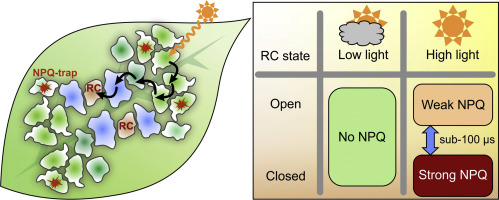当前位置:
X-MOL 学术
›
BBA Bioenerg.
›
论文详情
Our official English website, www.x-mol.net, welcomes your feedback! (Note: you will need to create a separate account there.)
Instantaneous switching between different modes of non-photochemical quenching in plants. Consequences for increasing biomass production.
Biochimica et Biophysica Acta (BBA) - Bioenergetics ( IF 4.3 ) Pub Date : 2019-11-14 , DOI: 10.1016/j.bbabio.2019.148119 Herbert van Amerongen 1 , Jevgenij Chmeliov 2
Biochimica et Biophysica Acta (BBA) - Bioenergetics ( IF 4.3 ) Pub Date : 2019-11-14 , DOI: 10.1016/j.bbabio.2019.148119 Herbert van Amerongen 1 , Jevgenij Chmeliov 2
Affiliation

|
Photosynthetic productivity usually saturates far below the maximum solar light intensity, meaning that in those conditions many absorbed photons and the resulting electronic excitations of the pigment molecules can no longer be utilized for photosynthesis. To avoid photodamage, various protection mechanisms are induced that dissipate excess excitations, which otherwise could lead to the formation of harmful molecular species like singlet oxygen. This Non-Photochemical Quenching (NPQ) of excitations can be monitored via a decrease of the chlorophyll fluorescence. There is consensus that in plants 1) there are at least two major NPQ (sub)processes and 2) NPQ (de)activation occurs on various time scales, ranging from (tens of) seconds to minutes. This relatively slow switching has a negative effect on photosynthetic efficiency, and Kromdijk et al. demonstrated in 2016 (Science 354, 857) that faster switching rates can lead to increased crop productivity. Very recently, we were involved in the discovery of a new NPQ process that switches off well within a millisecond (Farooq et al. (2018) Nat. Plants 4, 225). Here we describe the current level of knowledge regarding this process and discuss its implications.
中文翻译:

植物中非光化学猝灭的不同模式之间的瞬时切换。增加生物质产量的后果。
光合作用的生产力通常饱和度远远低于最大太阳光强度,这意味着在这些条件下,许多吸收的光子以及由此产生的色素分子的电子激发不再能够用于光合作用。为了避免光损伤,需要引入各种保护机制来消除多余的激励,否则可能导致有害分子物种(如单线态氧)的形成。可以通过减少叶绿素荧光来监测这种非光化学猝灭(NPQ)激发。普遍认为,在工厂中1)至少有两个主要的NPQ(子)过程,以及2)NPQ(去激活)发生在从(几十秒)到几分钟的各种时间范围内。这种相对较慢的转换对光合作用效率有负面影响,Kromdijk等人。在2016年证明(Science 354,857),更快的转换速度可以提高农作物的生产力。最近,我们参与了一个新的NPQ过程的发现,该过程可以在一毫秒内很好地关闭(Farooq等人(2018)Nat.Plants 4,225)。在这里,我们描述了有关此过程的当前知识水平,并讨论了其含义。
更新日期:2019-11-14
中文翻译:

植物中非光化学猝灭的不同模式之间的瞬时切换。增加生物质产量的后果。
光合作用的生产力通常饱和度远远低于最大太阳光强度,这意味着在这些条件下,许多吸收的光子以及由此产生的色素分子的电子激发不再能够用于光合作用。为了避免光损伤,需要引入各种保护机制来消除多余的激励,否则可能导致有害分子物种(如单线态氧)的形成。可以通过减少叶绿素荧光来监测这种非光化学猝灭(NPQ)激发。普遍认为,在工厂中1)至少有两个主要的NPQ(子)过程,以及2)NPQ(去激活)发生在从(几十秒)到几分钟的各种时间范围内。这种相对较慢的转换对光合作用效率有负面影响,Kromdijk等人。在2016年证明(Science 354,857),更快的转换速度可以提高农作物的生产力。最近,我们参与了一个新的NPQ过程的发现,该过程可以在一毫秒内很好地关闭(Farooq等人(2018)Nat.Plants 4,225)。在这里,我们描述了有关此过程的当前知识水平,并讨论了其含义。



























 京公网安备 11010802027423号
京公网安备 11010802027423号